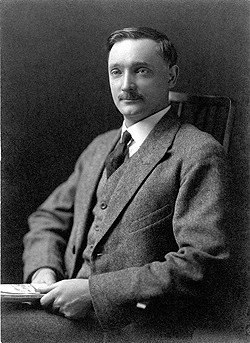<Back to Index>
- Indologist and Theosophist Ernest Egerton Wood, 1883
PAGE SPONSOR

Professor Ernest Egerton Wood (18 August 1883 - 17 September 1965) was a noted English yogi, theosophist, Sanskrit scholar, and author of numerous books, including Concentration - An Approach to Meditation, Yoga and The Pinnacle of Indian Thought (1967).
Born in Manchester, England, Wood was educated at the Manchester Municipal College of Technology, where he studied chemistry, physics and geology. Because of his interest in Buddhism and Yoga, he began to learn the Sanskrit language.
As a young man, Wood became interested in Theosophy after listening to lectures by the theosophist Annie Besant, whose personality impressed him greatly. He joined the society's Manchester lodge and in 1908 followed Besant, who had become President of the Theosophical Society Adyar, to India. Wood became one of her assistants, working with Besant and Charles Webster Leadbeater, who had arrived in Adyar in 1909.
Wood observed the discovery of the boy Jiddu Krishnamurti by Leadbeater, who soon declared Krishnamurti to be the vehicle for the "coming World Teacher". Wood's account of this discovery is in his autobiography, Is this Theosophy...?, published in 1936, and in two articles written after that.
At Besant's suggestion, Wood became involved in education, and after 1910, he served as headmaster of several schools and colleges founded by the Theosophical Society. Wood became Professor of Physics, Principal and President of the Sind National College and the Madanapalle College, both teaching colleges of the Bombay and Madras Universities. Wood promoted theosophical ideas, conducting lecturing tours and publishing numerous articles, essays and books on a variety of theosophical subjects, among them a digest of Helena P. Blavatsky's Secret Doctrine. He lectured throughout India and traveled to many countries in Asia, Europe and the Americas. He continued to reside in India until the close of World War II, when he relocated to the United States.
Wood become disillusioned about the future of the Theosophical Society and began to study the yoga classics. Following the Krishnamurti affair, which caused a splitting of the society, Wood campaigned for election to the office of president after Annie Besant's death in 1933. He was defeated by George Arundale, one of Charles Leadbeater's close allies, in a campaign that Wood later described as unfair and questionable. Disenchanted with the society's direction, but impressed with the now mature and independent Krishnamurti, Wood turned to Yoga.
In India, Wood had encountered many yogis and Hindu pundits. As a practicing yogi, vegetarian and teetotaler, having adopted this lifestyle after reading Sir Edwin Arnold's The Light of Asia in his boyhood, he was warmly received by Indian yogis, many of whom became Wood's friends and advisers. During his early years in Adyar, the Head of the Vedantic Monastery Shri Shringeri Shivaganga Samasthanam in Mysore Province, Sri Jagat Guru Shankara Charya Swami, bestowed upon Wood the title of "Shri Sattwikagraganya" in recognition of his efforts to introduce Indian pupils to Sanskrit.
Wood did not officially become a student of any Indian master. However, during a visit to New York in 1928(?), he again met with Krishnamurti, who was leaving the Theosophical Society to become an independent teacher, renouncing the ceremonies and occult hierarchies created by the leadership of the Society. This meeting affected Wood deeply, and he returned to the classic yoga literature as a source of inspiration. Wood spent his remaining years writing and publishing on yoga. He moved to the United States, where he served for a short time as president and dean of the American Academy of Asian Studies in San Francisco, and later moved to Houston, Texas, working for the University of Houston, Texas. Together with his wife, Hilda, Wood helped in the establishment of School of the Woods, a Montessori school in Houston, Texas, which was named after them.
Shortly after his arrival in India, Wood had begun translating the Indian classics, such as the Garuda Purana. In the late 1920s, he began a thorough study of the Yoga classics with the assistance of several Hindu scholars, leading to the publication of numerous translations of famous yoga texts such as the Bhagavad Gita, Pata˝jali's Yoga Sutras, Shankara's Viveka Chudamani. In his commentaries to these translations, Wood tried to make these texts' philosophical ideas applicable to modern life. His writings contain many references to his own practical experiences in these matters. Together with his concise treatises of yoga, such as the volume Yoga, Penguin Books,1959 / 62, and his earlier writings on concentration and memory training, Wood's works contain a complete introduction to the classic texts of Raja Yoga, or the yoga of the mind, with a sparing use of Sanskrit expressions.
Wood died on September 17, 1965, days after finishing his translation of Shankara's Viveka Chudamani, which was posthumously published and entitled The pinnacle of Indian thought.